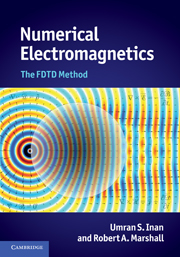Book contents
- Frontmatter
- Contents
- Preface
- 1 Introduction
- 2 Review of electromagnetic theory
- 3 Partial differential equations and physical systems
- 4 The FDTD grid and the Yee algorithm
- 5 Numerical stability of finite difference methods
- 6 Numerical dispersion and dissipation
- 7 Introduction of sources
- 8 Absorbing boundary conditions
- 9 The perfectly matched layer
- 10 FDTD modeling in dispersive media
- 11 FDTD modeling in anisotropic media
- 12 Some advanced topics
- 13 Unconditionally stable implicit FDTD methods
- 14 Finite difference frequency domain
- 15 Finite volume and finite element methods
- Index
5 - Numerical stability of finite difference methods
Published online by Cambridge University Press: 05 June 2012
- Frontmatter
- Contents
- Preface
- 1 Introduction
- 2 Review of electromagnetic theory
- 3 Partial differential equations and physical systems
- 4 The FDTD grid and the Yee algorithm
- 5 Numerical stability of finite difference methods
- 6 Numerical dispersion and dissipation
- 7 Introduction of sources
- 8 Absorbing boundary conditions
- 9 The perfectly matched layer
- 10 FDTD modeling in dispersive media
- 11 FDTD modeling in anisotropic media
- 12 Some advanced topics
- 13 Unconditionally stable implicit FDTD methods
- 14 Finite difference frequency domain
- 15 Finite volume and finite element methods
- Index
Summary
In Chapter 3 we looked very briefly at the stability of numerical algorithms. By trial and error, we found the condition in Section 3.4.1 that, for a phase velocity of 1 ft ns−1, we required Δt ≤ Δx, or else the solution would rapidly go unstable as time progressed. This condition is known as the Courant-Friedrichs-Lewy or CFL stability condition. In this chapter we will introduce a commonly used method for assessing the stability of finite difference methods. We will also investigate the source of instability and more formally derive the CFL condition.
The most commonly used procedure for assessing the stability of a finite difference scheme is the so-called von Neumann method, initially developed (like many other finite difference schemes) for fluid dynamics related applications. This stability analysis, based on spatial Fourier modes, was first proposed and used by J. von Neumann during World War II at Los Alamos National Laboratory [1, 2].
The von Neumann method is applied by first writing the initial spatial distribution of the physical property of interest (e.g., the voltage or the electric field) as a complex Fourier series. Then, we seek to obtain the exact solution of the finite difference equation (FDE) for a general spatial Fourier component of this complex Fourier series representation. If the exact solution of the FDE for the general Fourier component is bounded (either under all conditions or subject to certain conditions on Δx, Δt), then the FDE is said to be stable.
Information
- Type
- Chapter
- Information
- Numerical ElectromagneticsThe FDTD Method, pp. 113 - 131Publisher: Cambridge University PressPrint publication year: 2011
